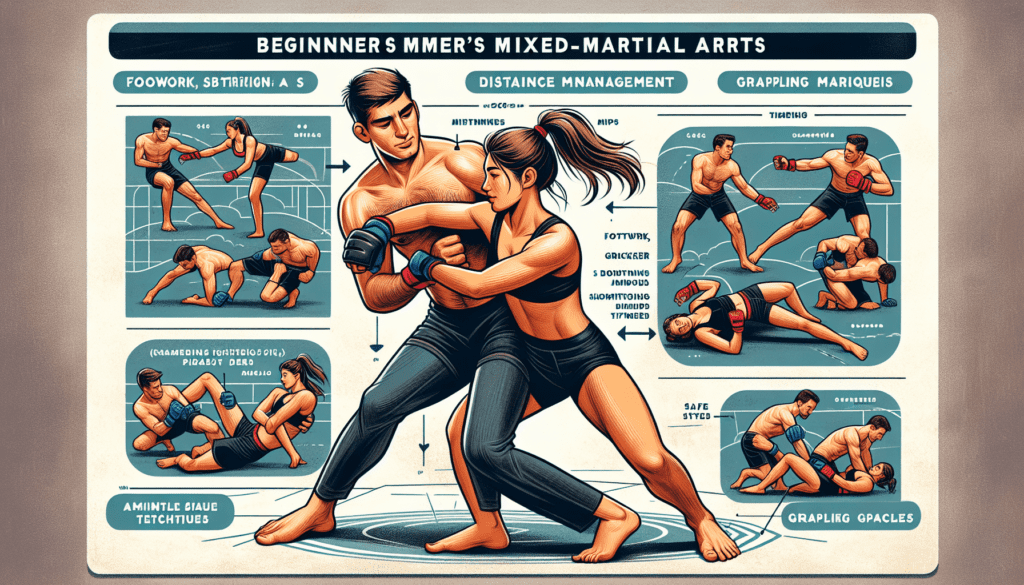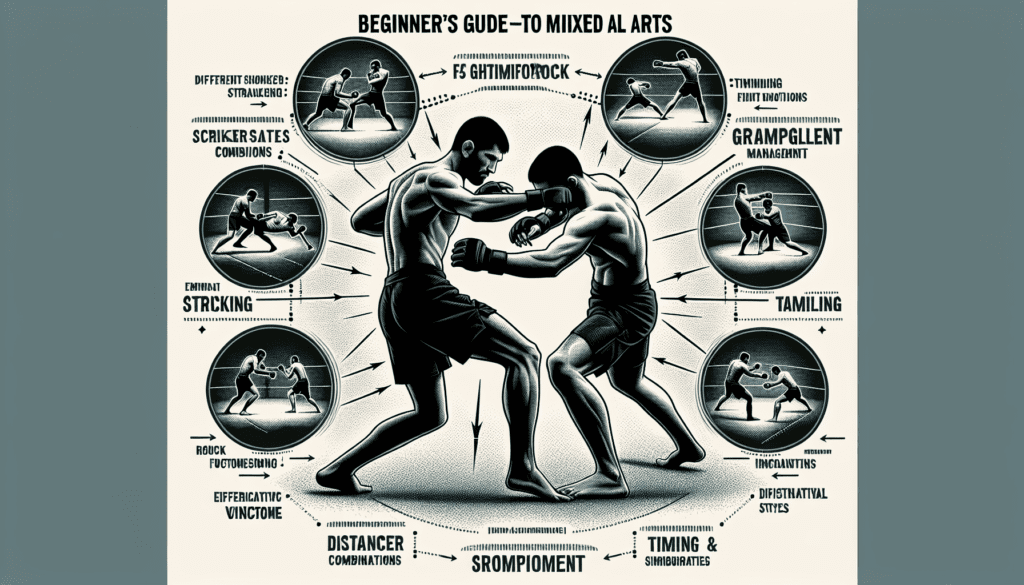Congratulations on taking your first step into the exciting world of MMA fight strategy! This beginner’s guide will equip you with the essential knowledge to navigate the intricate world of mixed martial arts. Whether you’re a novice curious about the sport or a budding fighter looking to gain an edge in the ring, this article will provide you with a firm foundation in the fundamentals of MMA fight strategy. Get ready to absorb valuable insights that will empower you to approach fights with confidence and skill. Let’s jump right in!
Understanding MMA
What is MMA?
Mixed Martial Arts (MMA) is a combat sport that combines various techniques from different fighting styles and allows competitors to use both striking and grappling techniques. It is a dynamic and intense sport that tests the skills and abilities of fighters in a controlled environment.
Rules of MMA
MMA has a set of rules that govern the sport and ensure the safety of the fighters. While the rules can vary depending on the promotion or organization, some common rules include no eye gouging, no strikes to the back of the head, and no biting. Fighters are also not allowed to strike the groin or use any illegal techniques during the match.
Different fighting styles in MMA
One of the aspects that make MMA so intriguing is the wide variety of fighting styles that can be utilized. Some of the most common styles seen in MMA include boxing, kickboxing, Muay Thai, Brazilian Jiu-Jitsu, wrestling, and judo. Each style brings its own unique techniques and strategies to the octagon, making MMA a sport of versatility and tactical thinking.
Developing Skills
Learning basic techniques
To excel in MMA, it is crucial to learn the fundamental techniques of each fighting style. This includes proper punching and kicking techniques, understanding footwork, and mastering basic grappling moves. Starting with the basics provides a solid foundation to build upon as you progress in your MMA journey.
Building strength and conditioning
MMA requires athletes to be in peak physical condition. Building strength and conditioning is essential for endurance, explosive power, and injury prevention. Incorporate weightlifting, bodyweight exercises, and cardio training into your routine to improve your overall strength and stamina.
Developing agility and speed
Agility and speed play a significant role in MMA. Quick movements and fast reaction times can give you an edge over your opponents. Incorporate agility ladder drills, plyometric exercises, and speed training into your workouts to enhance your agility and speed inside the octagon.

Training Methods
Choosing the right gym and trainers
The right gym and trainers can make a world of difference in your MMA journey. Look for a gym that has experienced coaches, a supportive community, and a variety of training options. Take the time to research and visit different gyms to find the one that aligns with your goals and provides the necessary guidance to improve your skills.
Creating a training schedule
Consistency is key when it comes to MMA training. Creating a training schedule helps you stay organized and ensures that you train all aspects of the sport effectively. Dedicate specific days to striking, grappling, conditioning, and rest. Having a structured training schedule will help you make the most of your time and progress faster.
Sparring and drilling techniques
Sparring is a crucial aspect of MMA training as it allows you to apply the techniques you’ve learned in a realistic combat scenario. Find training partners who can challenge you and engage in controlled sparring sessions to simulate the intensity of a fight. Additionally, drilling techniques repeatedly helps in muscle memory and enhances your overall technique execution.
Striking Techniques
Punches and combinations
Punches are an essential part of MMA and can be executed with different techniques and combinations. Straight punches, hooks, uppercuts, and overhands are all effective striking techniques that can be used to land significant blows. Learning proper punching form and mastering combinations will help you effectively strike your opponents.
Kicks and knees
Kicks and knees provide fighters with additional striking options. Roundhouse kicks, front kicks, and sidekicks can be used to create distance and deliver powerful strikes. Knees, on the other hand, are devastating at close range and can cause significant damage to an opponent. Proper technique and timing are crucial when using kicks and knees effectively.
Elbows and clinching
Elbows are devastating strikes in MMA due to their sharpness and close-quarter effectiveness. Learning how to properly throw elbows and incorporate them into your striking combinations can give you a distinct advantage. Additionally, understanding clinching techniques and utilizing them effectively can allow you to control your opponent and deliver devastating strikes from inside the clinch.

Ground Fighting
The importance of grappling
Grappling is a crucial aspect of MMA, as many fights end up on the ground. Having a solid grappling foundation allows you to control your opponent, defend against submissions, and potentially finish the fight with a submission of your own. Brazilian Jiu-Jitsu and wrestling are two popular grappling styles that are essential for every MMA fighter to master.
Submission techniques
Submission techniques in MMA include chokes, joint locks, and other methods of forcing your opponent to submit. Understanding the various submission holds and how to apply them effectively can give you a significant advantage when a fight goes to the ground. Proper technique, timing, and the ability to transition between submissions are essential for success in this aspect of MMA.
Escaping from holds
Equally important as submission techniques is the ability to escape from holds. Being able to defend against and escape from submissions is crucial for survival on the ground. Learning proper escape techniques and practicing them regularly will help you avoid being caught in potentially fight-ending submissions.
Defensive Strategies
Blocking and evading strikes
In MMA, defense is just as important as offense. Learning how to effectively block and evade strikes can minimize the damage you take and create openings for counterattacks. Proper hand positioning, footwork, and head movement are essential skills that can help you avoid punches, kicks, and other strikes.
Countering attacks
Being able to counter your opponent’s attacks can provide a significant advantage during a fight. Timing and precision are key when executing counterattacks. By analyzing your opponent’s movements and predicting their strikes, you can effectively counter with strikes or takedowns, turning their aggression into your advantage.
Effective defensive footwork
Footwork plays a vital role in both offense and defense. By utilizing effective defensive footwork, you can maintain distance, create angles, and evade attacks. Moving laterally, circling, and using proper distance management will help you control the fight and decrease the chances of being hit.
Fight Psychology
Analyzing opponents
Understanding your opponent’s strengths, weaknesses, and tendencies is crucial in developing a game plan for a fight. Analyze their previous fights, study their techniques, and identify patterns in their behavior. By gaining insights into their fighting style, you can strategize and exploit their weaknesses during the fight.
Creating game plans
Having a well-thought-out game plan is essential in MMA. Analyze both your own strengths and weaknesses and those of your opponent to create a strategy that maximizes your chances of success. This includes determining the ideal range, identifying target areas, and considering possible scenarios that may arise during the fight.
Maintaining focus and composure
MMA fights can be highly intense and unpredictable, so it is crucial to maintain focus and composure throughout the bout. Mental toughness and the ability to stay calm under pressure will help you make quick and effective decisions during the fight. Developing mental strength through techniques such as visualization, meditation, and positive self-talk can significantly contribute to your success inside the octagon.
Cardiovascular Conditioning
Building endurance
Endurance is vital in MMA, as fights can last multiple rounds with intense physical exertion. Incorporate cardiovascular exercises such as running, swimming, or cycling into your training routine to improve your endurance. High-intensity interval training (HIIT) and long-distance endurance training are both effective methods to increase your stamina inside the cage.
Interval training
Interval training is an excellent way to replicate the bursts of high intensity that occur during a fight. Alternating between short periods of intense exercise and active recovery allows your body to adapt to the demands of MMA. Incorporate interval training exercises such as sprints, bag work, or shadowboxing into your training routine to improve your anaerobic fitness and recovery.
Nutrition and hydration
Proper nutrition and hydration play a crucial role in optimizing your performance in MMA. Fueling your body with balanced meals that include lean proteins, complex carbohydrates, and healthy fats will provide the energy you need for training and recovery. Additionally, staying hydrated throughout the day, especially during training sessions, is essential for maintaining peak performance.
Fight Preparation
Mental and physical preparation
Preparing both mentally and physically for a fight is essential to perform at your best. Conditioning your body through rigorous training, maintaining a healthy lifestyle, and getting enough rest are crucial aspects of physical preparation. Mental preparation involves visualizing success, managing pre-fight nerves, and staying focused on your game plan.
Weight management
Weight management is a significant consideration in MMA, as fighters compete in specific weight classes. Adhering to a proper diet, working with a nutritionist, and implementing weight cutting techniques can help you safely reach your desired weight for the fight. It is important to approach weight management with caution to prevent adverse effects on your health and performance.
Stretching and warm-up routines
Stretching and warming up before training and fights are vital to prevent injuries and ensure optimal performance. Dynamic stretching, which involves active movements that mimic the movements of your sport, helps increase blood flow and prepare your muscles for action. Additionally, incorporating mobility exercises into your warm-up routine improves joint flexibility and overall movement.
Competitive Strategies
Assessing strengths and weaknesses
Knowing your own strengths and weaknesses is essential in developing a competitive strategy. Understanding where you excel and where you may be vulnerable allows you to capitalize on your strengths while minimizing the impact of your weaknesses. Regular self-assessment and feedback from coaches and teammates can aid in this assessment process.
Exploiting opponents’ weaknesses
Identifying and exploiting your opponent’s weaknesses is a critical component of a successful fight strategy. By analyzing their previous fights and observing their techniques, you can pinpoint areas where they may be vulnerable. Strategize to exploit these weaknesses by creating game plans centered around neutralizing their strengths and exposing their vulnerabilities.
Adapting strategies during a fight
Flexibility and adaptability are key qualities for any successful fighter. MMA bouts can be unpredictable, and being able to adjust your strategy in real-time is crucial. Assessing your opponent’s reactions and adapting your approach based on the evolving circumstances of the fight can give you a significant advantage and increase your chances of emerging victorious.
With a solid understanding of the fundamentals, dedicated training, and a strategic approach, you can embark on your journey in the exciting world of MMA. Remember, it takes time, patience, and perseverance to become a skilled fighter. So, lace up your gloves, step into the gym, and embrace the challenges that lie ahead. Good luck on your MMA journey!

